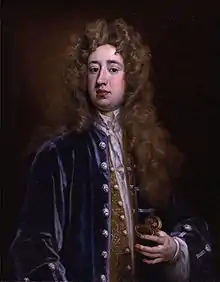George Macartney (British Army officer)
Lieutenant-General George Macartney or Maccartney (c. 1660–1730) was an Irish-born professional soldier who was involved in the celebrated Hamilton–Mohun Duel of 1712.
George Macartney | |
|---|---|
| Born | 1660 Belfast |
| Died | 1730 Kensington, London |
| Buried | |
| Allegiance | |
| Service/ | Army |
| Years of service | 1694-1752 |
| Rank | General |
| Unit | 29th Foot; 13th Foot; 11th Hussars |
| Commands held | Military Commander, Counties Down and Antrim; |
| Battles/wars | War of the Spanish Succession1702-1714 Almansa; War of the Quadruple Alliance Capture of Vigo 1719 |
| Other work | Governor of Sheerness 1729-1745 Governor of Edinburgh Castle 1745-1752 |
Biography
He was the elder son of George Macartney, son of the last of the Macartneys of Blacket in Scotland, who had settled at Belfast in 1630; his mother Martha was of the same family as Sir John Davies. His younger brother Isaac served as High Sheriff of Antrim and was the father of William Macartney MP.[1]
Macartney entered the Army during the reign of William III,[2] and served with much credit under the Duke of Marlborough and Prince Eugene.[1] After the War of the Spanish Succession began, he was appointed Colonel of a new regiment, McCartney's Regiment of Foot, which initially served under Marlborough in Flanders before being sent to Spain in 1706.[3] He was wounded at the Battle of Almanza, where the regiment suffered heavy casualties and after returning to the Low Countries in 1709, was promoted Major-general.[2] His regiment fought at the siege of Douai in 1710, after which he became Lieutenant-General.[3]

In 1712, Macartney acted as second to Lord Mohun, in the Hamilton–Mohun Duel where both parties were killed. Like Mohun, Macartney was a Whig and was accused by his Tory opponents of stabbing Hamilton while the duellists were rolling on the ground. It was then common practice for seconds to join the fight and both MacCartney and the unrelated Colonel Hamilton were arrested; McCartney escaped to Hanover, where he remained until 1714, when he returned with George I.[4]
Soon after this, he demanded to be tried for the offence which had been laid to his charge, and on the evidence of the keepers of Hyde Park, who had witnessed the duel throughout all its phases, was honourably acquitted.[1] His former regiment having been disbanded at the peace of Utrecht, he was appointed to the colonelcy of the Royal North British Fusiliers on 12 July 1716,[5] from which he was removed on 9 March 1727 to the Carabiniers, and he retained this appointment until his decease on 7 July 1730.[2] He was at the time of his death commander-in-chief of the forces in Ireland and governor of Portsmouth. He married the widow of General Douglas, and by her had issue.[1]
References
- Sir Bernard Burke, A Genealogical and Heraldic Dictionary of the Landed Gentry of Great Britain and Ireland (1863) vol. II, p. 926.
- Richard Cannon, Historical Record of the Sixth Regiment of Dragoon Guards, or the Carabineers (1839) p. 96.
- Dalton, Charles (1904). English Army Lists and Commission Registers, 1661-1714 Volume V (2015 ed.). Sagwan Press. p. 224. ISBN 978-1297889776.
- Banks, Stephen (2010). A Polite Exchange of Bullets: The Duel and the English Gentleman, 1750–1850. Boydell & Brewer. ISBN 978-1843835714.
- Cannon, Historical Record of the Twenty-First Regiment, or the Royal North British Fusiliers (1849) p. 56.
External links
| Wikisource has the text of the 1885–1900 Dictionary of National Biography's article about Maccartney, George. |
| Military offices | ||
|---|---|---|
| Preceded by Regiment raised |
Colonel of Macartney's Regiment of Foot 1704–1709 |
Succeeded by Richard Sutton |
| Preceded by Sir Thomas Prendergast |
Colonel of Macartney's Regiment of Foot 1709–1710 |
Succeeded by Richard Kane |
| Preceded by The Earl of Orrery |
Colonel of the Royal North British Fuzileers 1716–1727 |
Succeeded by Sir James Wood |
| Preceded by The Viscount Shannon |
Colonel of the King's Regiment of Carabineers 1727–1730 |
Succeeded by The Earl of Deloraine |